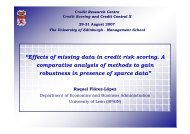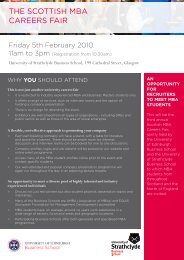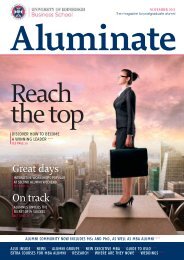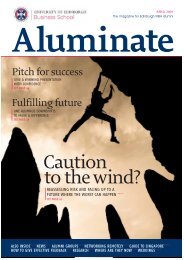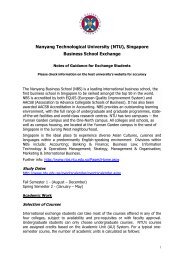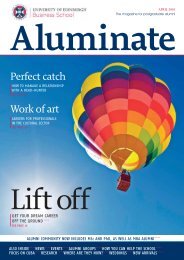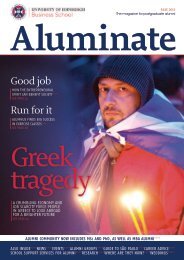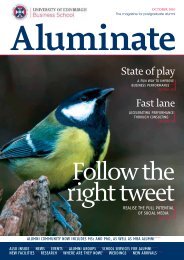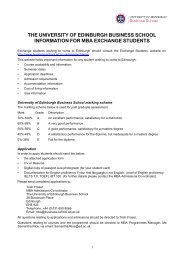killed Saab Automobile? - Business School - University of Edinburgh
killed Saab Automobile? - Business School - University of Edinburgh
killed Saab Automobile? - Business School - University of Edinburgh
Create successful ePaper yourself
Turn your PDF publications into a flip-book with our unique Google optimized e-Paper software.
Under this revised policy, attention has shifted away from joint ventures with foreign firms, towards<br />
developing local capabilities. Following the lessons <strong>of</strong> several failed acquisitions (e.g. the acquisition <strong>of</strong><br />
faltering Ssangyong by SAIC) there is a growing concern that taking over failing foreign auto firms is not<br />
a good route route forward.<br />
As Williamson and Raman describe in the 2011 article, there have been several common mistakes in<br />
Chinese acquisitions <strong>of</strong> foreign firms in all industries, not just the auto industry. First, Chinese firms<br />
have pursued inexpensive deals with unpr<strong>of</strong>itable businesses that <strong>of</strong>ten were lacking any economic<br />
case for continuation. Pang da and Youngman’s pursuit <strong>of</strong> <strong>Saab</strong> could well fit into this category.<br />
Secondly, there has been a focus on companies whose value consisted mostly <strong>of</strong> brands, systems,<br />
culture and people -- all <strong>of</strong> which are difficult to integrate across borders lxxiv .<br />
Learning from past mistakes, the NDRC now actively discourages deals that were not deemed to be in<br />
the national interest <strong>of</strong> developing globally competitive car firms. In 2009, the proposed acquisition <strong>of</strong><br />
GM’s Hummer by Sichuan Tengzhong Heavy Industrial Machinery was blocked on the grounds that the<br />
Chinese acquirer had insufficient capital and experience. In this context, it is unsurprising that Chinese<br />
authorities were not supportive <strong>of</strong> the various deals proposed for <strong>Saab</strong>. Neither the Hawtai and the<br />
Pang Da-Youngman acquisitions <strong>of</strong> <strong>Saab</strong> would clearly have created a globally competitive car firm.<br />
The NDRC never formally endorsed the <strong>Saab</strong> acquisition by the Youngman-PangDa consortium in<br />
public, although ‘in principle’ support was allegedly voiced infromally.<br />
Still, one might ask what the Pang Da and Youngman’s purchase <strong>of</strong> <strong>Saab</strong> might have achieved had it<br />
gone ahead, both for <strong>Saab</strong> and for Pang Da and Youngman? For <strong>Saab</strong>, the most immediate benefit<br />
would have been the infusion <strong>of</strong> cash to meet its outstanding liabilities, which - taking an optimistic view<br />
- could have restarted production in the near term. Furthermore, there was a promise <strong>of</strong> investment to<br />
raise production to 200,000 units. The other great opportunity for <strong>Saab</strong> was better access to the<br />
Chinese car market, which is the second-largest in the world, and still the fastest growing. Through<br />
Pang-Da's dealer network this access might have been facilitated in a reasonably short period <strong>of</strong> time.<br />
On the other hand, in <strong>Saab</strong>’s main established markets (the US, UK and Sweden) the 9-5 had already<br />
proved to be largely a market failure, unable to generate sufficient sales to allow the company to breakeven,<br />
and this was before a break in production <strong>of</strong> several months and associated bad press. Even<br />
taking a lasting damage to the brand aside, the press coverage <strong>of</strong> 2010 and 2011 put enormous strain<br />
on residual values <strong>of</strong> <strong>Saab</strong> vehicles. As a result it became virtually impossible to sell <strong>Saab</strong> cars, and at<br />
times even residual value guarantees had to be granted to buyers, making the sales deeply risky and<br />
unpr<strong>of</strong>itable for <strong>Saab</strong>. Against this backdrop it seems questionable whether an increase in production<br />
capacity would have resulted in any major improvement <strong>of</strong> <strong>Saab</strong>'s financial position.<br />
Further down the line, a key assumption behind any merger is that firms will be able to share<br />
technology and generate economies <strong>of</strong> scale. Here it is even more questionable whether there would<br />
have been any synergies between <strong>Saab</strong> and Youngman, which to date has built buses (mostly under<br />
license) and only recently started producing entry-level passenger cars that were co-developed with<br />
Lotus Engineering. In our assessment there was little or no synergy in production activities.<br />
So what was in it for the Chinese partners? This question is harder to answer, as both Pang-Da and<br />
Youngman played their cards close to their chests. For one, the new <strong>Saab</strong> 9-5 <strong>of</strong>fered a quick and<br />
economical access to up-to-date (GM-based) vehicle technology, as well as a globally recognised<br />
automotive brand. Both are rare in the Chinese car market, and generally expensive to acquire.<br />
28




